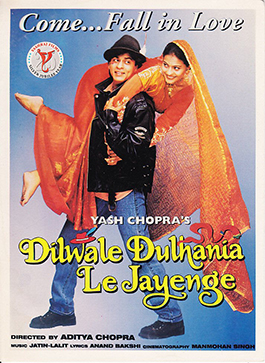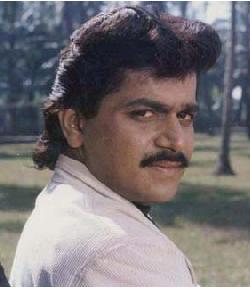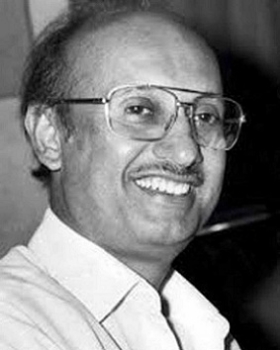Related Research Articles

Hindi cinema, popularly known as Bollywood and formerly as Bombay cinema, refers to the film industry based in Mumbai, engaged in production of motion pictures in Hindi language. The popular term Bollywood, is a portmanteau of "Bombay" and "Hollywood". The industry is a part of the larger Indian cinema, which also includes South Indian cinema and other smaller film industries.

Dilwale Dulhania Le Jayenge, also known by the initialism DDLJ, is a 1995 Indian Hindi-language musical romance film written and directed by Aditya Chopra in his directorial debut and produced by his father Yash Chopra. Released on 20 October 1995, the film stars Shah Rukh Khan and Kajol. The plot revolves around Raj and Simran, two young non-resident Indians, who fall in love during a vacation through Europe with their friends. Raj tries to win over Simran's family so the couple can marry, but Simran's father has long since promised her hand to his friend's son. The film was shot in India, London, and Switzerland, from September 1994 to August 1995.

Yash Raj Chopra was an Indian film director and film producer who worked in Hindi cinema. The founding chairman of the film production and distribution company Yash Raj Films, Chopra was the recipient of several awards, including 6 National Film Awards and 8 Filmfare Awards. He is considered among the best Hindi filmmakers, particularly known and admired for his female based romantic films. For his contributions to film, the Government of India honoured him with the Dadasaheb Phalke Award in 2001, and the Padma Bhushan in 2005. In 2006, British Academy of Film and Television Arts presented him with a lifetime membership, making him the first Indian to receive the honour.

Laxmikant Berde was an Indian Marathi language film actor who appeared in Marathi and Hindi movies. Known for his highly energetic slapstick performances, Berde started his career as an employee in the production company Mumbai Marathi Sahitya Sangh and then played supporting roles in a few Marathi stage plays. In 1983–84, he first became famous with the Marathi play Tur Tur.

Hum Aapke Hain Koun..! also known by the initialism HAHK, is a 1994 Indian Hindi-language musical romantic drama film written and directed by Sooraj Barjatya and produced by Rajshri Productions. The film stars Madhuri Dixit and Salman Khan and celebrates Indian wedding traditions by means of a story of a married couple and the relationship between their families; a story about sacrificing one's love for one's family. The basic plot is based on studio's earlier film Nadiya Ke Paar (1982), which was based on Keshav Prasad Mishra's Hindi novel Kohbar Ki Shart. The film features music by Raamlaxman who also composed a 14-song soundtrack, an unusually large number of songs for that period.

Manmohan Desai was an Indian film producer and director. He was one of the most successful filmmaker of the 70s and 80s. Desai is now considered one of the most influential film director of Bollywood and a pioneer of making masala film.

Ganga Jamna, also transliterated as Ganga Jamuna or Gunga Jumna, is a 1961 Indian crime drama film, written and produced by Dilip Kumar, and directed by Nitin Bose, with dialogues written by Wajahat Mirza; Kumar later said that he also ghost-directed and edited the film. It stars Dilip Kumar with Vyjayanthimala and his real-life brother Nasir Khan in the leading roles. Set in the rural Awadh region of Northern India, the film tells the story of two impoverished brothers, Ganga and Jamna, and their poignancy and sibling rivalry on opposing sides of the law, one a dacoit criminal and the other a police officer. The film was also notable for its Technicolor production, use of the Awadhi dialect, and its rustic setting, being a defining example of the dacoit film genre. It was ranked 11th in Outlook Magazine's poll considering 25 leading Indian directors' vote for Bollywood's greatest films in 2003.

Anthropology of media is an area of study within social or cultural anthropology that emphasizes ethnographic studies as a means of understanding producers, audiences, and other cultural and social aspects of mass media.
Guru Dutt Films Pvt. Ltd. was an Indian film production company, founded by actor-director Guru Dutt in 1955. Guru Dutt Films, along with the Guru Dutt team, saw some of its best works during the 1950s and 1960s, also sometimes referred to as the "Golden age of Indian cinema."

Kisan Kanya was a 1937 Hindi Cinecolor feature film which was directed by Moti Gidwani and produced by Ardeshir Irani of Imperial Pictures. It is largely remembered by the Indian public on account of it being India's first indigenously made colour film.
Ranjit Studios, also known as Ranjit Movietone, was an Indian film production company with studio facilities located in Mumbai, Maharashtra, India. It produced films between 1929 and mid-1970s. The studio was founded by Chandulal Shah along with Gohar Kayoum Mamajiwala. It was one of the three largest studios in Bollywood of its time, besides Kohinoor Film Company and Imperial Film Company.
Manzilein Aur Bhi Hain is a 1974 Bollywood crime thriller film directed by Mahesh Bhatt, and starring Kabir Bedi, Prema Narayan and Gulshan Arora in lead roles. The rights of this film are now owned by Glamour Eyes Films.

Amit Khanna is an Indian film producer, director, writer, and journalist. He was the founder chairman of Reliance Entertainment, former president of the Producers Guild of India, and the founder trustee of the Mumbai Academy of the Moving Image. He is credited with having coined the term Bollywood. Khanna has also won three National Film Awards as a producer and lyricist.

Bhakta Vidur is a 1921 silent Indian film directed by Kanjibhai Rathod and made under Kohinoor Film Company banner. In this film the Hindu mythological character Vidura was moulded on the personality of Mohandas Karamchand Gandhi. This was the first Indian film to face a ban.

Hindi film distribution circuits comprises territories which have been created by film distributors for releasing Hindi cinema or Hindustani cinema across India. The six distribution circuits were created in 1930s after the advent of the first talkie in 1931. These circuits were:
100 Crore Club is an unofficial designation by the Indian film trade and the media, related to Indian-language films that have net ₹100 crore or more in India after deducting the entertainment tax. By 2012, the ₹100 crore box office target had become "a new benchmark for a film to be declared a hit", and those affiliated with the 100 Crore Club were considered part of the "elite strata" within the Indian film community.
Madhu Varma Mantena is an Indian film producer and entrepreneur involved in the production and distribution of films across Hindi, Telugu, and Bengali cinema.
Indira Devi, born Effie Hippolet, was an actress of early silent Indian cinema.
References
- ↑ "Curriculum Vitae: Tejaswini Ganti". Academia.edu . Retrieved 25 April 2021.
- ↑ Kamat, Sameer (16 March 2012). "Indian film industry (Bollywood) – Perspectives and outlook". MBA Crystal Contents. Archived from the original on 16 January 2021. Retrieved 25 April 2021.
- 1 2 Pais, Arthur J. (10 April 2012). "'Hindi cinema has gained a certain cultural legitimacy'". Rediff.com . Archived from the original on 14 March 2017. Retrieved 25 April 2021.
- ↑ Renninger, Bryce J. (6 April 2012). "Movie Lovers We Love: Bollywood Anthropologist Tejaswini Ganti Explains Why There's No Indie Industry in India". IndieWire . Archived from the original on 22 January 2021. Retrieved 25 April 2021.
- ↑ Ganti, Tejaswini (7 March 2012). "Producing Bollywood: Inside the Contemporary Hindi Film Industry (Inglés) Tapa blanda – 7 Marzo 2012" [Producing Bollywood: Inside the Contemporary Hindi Film Industry (English) Paperback – 7 March 2012]. Amazon . Archived from the original on 14 April 2015. Retrieved 25 April 2021.